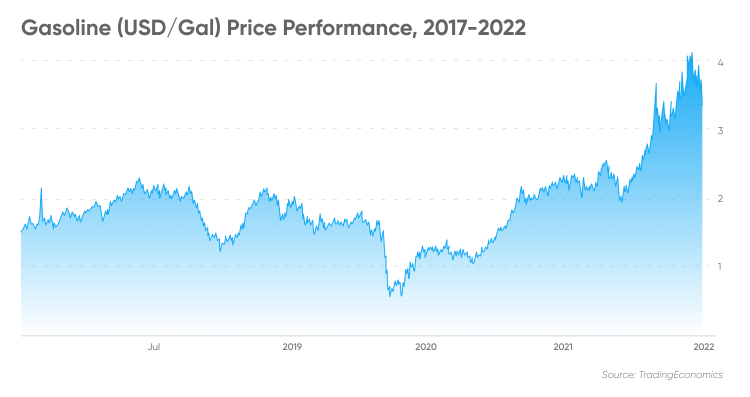Gasoline price forecast 2022-2030: Can price rebound on China’s returning demand?

Petrol (gasoline) prices have been steady but remain below a record high in June 2022, owing to a slowing economy that is denting demand and piling inventories.
US unleaded gasoline blendstock (RBOB) futures traded on the Chicago Mercantile Exchange (CME) have dropped about 47% as of January 2023, from a fresh all-time high of $4.33 per gallon in early June, on worries about slowing demand.
The risk of a global recession has risen as it has become clear that central banks in developed economies are adamant about continuing to raise interest rates to tame stubbornly high inflation rates.
High oil prices have started to dent consumption and the international Brent crude benchmark has eased to around $79 a barrel (bbl) in January from $139 in March, on concerns that monetary policy tightening by central banks would spur recession, denting demand.
However, an expected rebound in China’s energy demand, as the country prepares to lift all Covid-19 restrictions on travellers from 8 January 2023, may help to cushion slumping demand from developed markets.
In this article, we look into factors that are likely to continue to drive gasoline demand and explore the gasoline price forecast for 2023 and beyond.

Price drivers and news: Why is gasoline falling?
RBOB gasoline futures opened 2022 strongly at the $2.25 per gallon level in early January and continued to surge following Russia’s invasion of Ukraine on 24 February.
On 8 March futures soared to a new all-time high of $3.83/gal after the US, the UK and the European Union announced a ban on Russian energy imports as a sanction for the country’s invasion of Ukraine.
The announcement caused the Brent crude oil benchmark, the largest component of the gasoline price, to hit $139 a barrel. According to the US Energy Information Administration (EIA), crude oil cost 54% the price of a gallon of gasoline in October. Refining charges accounted for 22% of the fuel’s value, with taxes, distribution and marketing accounting for the remaining 24%.
“The gasoline price benchmark surge is driven by elevated crude oil prices and widening gasoline crack spreads on the back of diminishing refining capacity,” wrote Dominika Rzechorzek, an oil and gas analyst at Fitch Solutions, in reply to Capital.com’s questions.
“The most significant bullish factor currently impacting oil prices is the ongoing fallout from the Russia-Ukraine conflict. Prices have stayed elevated in the wake of Russia’s invasion of Ukraine, reflecting supply disruptions stemming from the conflict itself, as well as Western sanctions in place on Russia.”
Crack spreads are the price differences between wholesale petroleum products and crude oil. They are frequently used to calculate refining margins. Gasoline crack spreads have grown to average $50.10/bbl in May-June 2022 from $17.20/bbl in 2021, driven by diminishing refining capacity, according to Rzechorzek.
On the demand side, gasoline demand increased sharply as Covid-19 restrictions were lifted and reached just above 2019 levels at 10.4 million barrels per day (mb/d) by June, according to ANZ Research’s senior commodity strategist Daniel Hynes and commodity strategist Soni Kumari in a note on 3 November.
Tight supply to offset soft oil consumption
Oil prices and fuel prices have retreated in the past few months. The Brent crude price has eased since March to around $79.50/bbl at the time of writing on 6 January, dropping 7.4% year to date (YTD).
At the pumps, retail gasoline prices in the US have also dropped about 34.5% to $3.285/gal in January from a record of $5.016/gal on 14 June, according to the American Automobile Association (AAA) – their all-time high since the AAA began collecting pricing data in 2000, the association said.
According to Fitch Solutions, global oil supply will improve but markets will remain tight through 2023, with only moderate relief from high prices punctuated by bouts of volatility. The firm’s analysts wrote on 5 December:
IEA, in its December oil market report, forecast oil demand growth could slow to 1.6mb/d in 2023, from 2.3mb/d in 2022 as economic headwinds mount. World oil consumption was expected to reach 101.6mb/d in 2023.
On the supply side, crude oil supply growth is expected to slow to just 770kb/d in 2023, compared to 4.7mb/d gains in 2022, as the European Union ban on Russian crude imports and the G7 price cap take effect.
According to ANZ Research, OPEC+’s production cut and the EU’s sanctions on Russian oil could remove 2.5mb/d of oil supply from the market over the coming months, which will keep the market tight.
China, the bright spot in fuel demand
Global economic headwinds were expected to slow demand growth for oil and gas in 2023, dragged down by economic downturns in developed markets due to high interest rates and inflation. According to Fitch Solutions, total fuel consumption in developed markets will rise at a 0.5% annual rate in 2023.
In contrast, emerging markets will provide the bulk of growth in fuel consumption for 2023, in line with a stronger economic performance, the firm added.
The expected rebound in China’s energy demand after it ended its three years in Covid-19 self-isolation was expected to cushion the fall in global energy demand. Fitch Solutions projected China’s gross domestic product (GDP) growth at 5% for 2023, faster than global economic growth of 2%.
“The return of China’s crude demand to markets from both higher internal domestic consumption and increased exports of refined fuels will help buoy global fuel consumption growth for 2023. We forecast China’s fuel consumption to grow by 5.0% in 2023 in line with the strong return to growth expected,” the firm stated.
China announced in late December 2022 that it will scrap Covid-19 nucleic acid tests for international arrivals starting from 8 January, state media Xinhua reported. It will gradually increase the number of flights and optimise the distribution of routes.
The border reopening follows Beijing’s move to lift Covid-19 restrictions at home, after widespread protests over its draconian zero-Covid policy.
Gasoline price predictions: Analyst sentiment
In a note on 24 November, analysts at Fitch Solutions wrote that while gasoline prices have come off their highs, they would remain elevated above historic averages. Consumption growth in emerging markets was expected to offset declines in developed markets, while low inventories globally and a continued lack of new refining capacity growth will contribute to a tight fundamental outlook, albeit much improved from earlier this year.
The firm stated that there are several risks to its gasoline price forecast, but they are skewed to the downside due to the emerging effects of the broader macroeconomic slowdown.
China’s emergence from its zero-Covid policy will also impact gasoline consumption, but the country’s demand could be much lower than expected, the firm added.
Gasoline price forecast 2023
The EIA’s gasoline price forecast for 2023 saw the fuel retail price averaging $3.51/gal in 2023, down from $3.99/gal in 2022 as inventories build up, limiting upward pressure on prices, according to the agency’s short-term energy outlook released on 1 December.
Fitch Solutions revised downward its RBOB gasoline price for 2023 to $2.70/gal from $2.90 in its previous forecast made in July.
As of 6 January, in its gasoline price forecast, Trading Economics projected the fuel to trade at $2.59/gal by the end of the first quarter of 2023. The economic data provider forecast gasoline to trade at $2.92/gal in 12 months.
Long-term gasoline price forecast
Fitch Solutions and the EIA did not offer long-term gasoline price predictions.
Wallet Investor, an algorithm-based price forecasting service, can generate a longer-term gasoline futures price forecast based on historical data. According to the service’s forecast system, RBOB gasoline futures is a good long-term (1-year) investment.
RBOB gasoline futures were expected to trade at $2.672/gal by December 2023, according to Wallet Investor’s gasoline price forecast for 2023 as of 23 February. The service’s gasoline price forecast for 2025 saw the fuel to rise to $3.673/gal by December 2025, and to $4.770 by January 2028.
A gasoline price forecast for 2030 was not available due to uncertainty in crude oil prices and the overall global economic outlook over the longer term.
When considering analysts’ gasoline price predictions, it’s important to bear in mind that they can and do get their estimates wrong. You should always do your own research, considering all relevant market conditions.
FAQs
Is gasoline a good investment?
Fitch Solutions and ANZ Research predicted gasoline demand to soften in 2023 due to expected slowing economic growth in developed nations. It could hit the price and lead to potential losses. However, whether gasoline is a good investment for you depends on your risk tolerance, investing goals and portfolio composition.
You should do your own research, and never trade money that you cannot afford to lose.
Will gasoline go down?
Nobody knows for certain. Gasoline prices are expected to fall in the medium term, according to the US EIA, Fitch Solutions and Trading Economics, as the global economy slows and inventories rise.
But do bear in mind that analysts’ views and forecasts can be wrong, and that it is important to do your own research.
How much will gasoline cost in 2023?
The EIA predicted the retail gasoline price would average $3.51/gal in 2023, dropping from $3.99/gal in 2022. Fitch Solutions forecast the gasoline price to stand at $2.70/gal in 2023, while Wallet Investor expected the fuel to reach $2.793 in December 2023.
When considering analysts’ gasoline price predictions, it’s important to bear in mind that they can and do get their estimates wrong. Always do your own research.
Will gasoline ever run out?
As gasoline is produced from crude oil and other petroleum liquids, its availability is directly tied to the supply of oil. In early 2021, Swiss-based energy firm MET Group forecast global oil reserves to last 51 more years. Other sources estimate that the planet will run out of fossil fuels much earlier. A lot depends on how quickly countries transition to clean energy sources.
Markets in this article
Related topics



